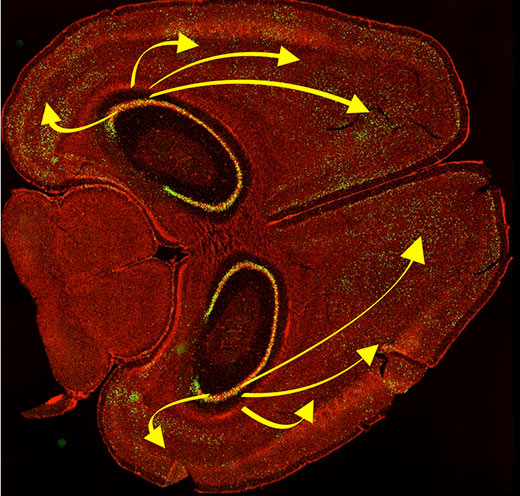Manipulating memory with light

During memory retrieval, cells in the hippocampus connect to cells in the brain cortex. (Photo illustration by Kazumasa Tanaka and Brian Wiltgen/UC Davis)
Optogenetics, pioneered by Karl Diesseroth at Stanford University, is a new technique for manipulating and studying nerve cells using light. The techniques of optogenetics are rapidly becoming the standard method for investigating brain function.
Kazumasa Tanaka, Brian Wiltgen and colleagues at UC Davis applied the technique to test a long-standing idea about memory retrieval. For about 40 years, Wiltgen said, neuroscientists have theorized that retrieving episodic memories — memories about specific places and events — involves coordinated activity between the cerebral cortex and the hippocampus, a small structure deep in the brain.
“The theory is that learning involves processing in the cortex, and the hippocampus reproduces this pattern of activity during retrieval, allowing you to re-experience the event,” Wiltgen said. If the hippocampus is damaged, patients can lose decades of memories.
But this model has been difficult to test directly, until the arrival of optogenetics.
Wiltgen and Tanaka used mice genetically modified so that when nerve cells are activated, they both fluoresce green and express a protein that allows the cells to be switched off by light. They were therefore able both to follow exactly which nerve cells in the cortex and hippocampus were activated in learning and memory retrieval, and switch them off with light directed through a fiber-optic cable.
They trained the mice by placing them in a cage where they got a mild electric shock. Normally, mice placed in a new environment will nose around and explore. But when placed in a cage where they have previously received a shock, they freeze in place in a “fear response.”
Tanaka and Wiltgen first showed that they could label the cells involved in learning and demonstrate that they were reactivated during memory recall. Then they were able to switch off the specific nerve cells in the hippocampus, and show that the mice lost their memories of the unpleasant event. They were also able to show that turning off other cells in the hippocampus did not affect retrieval of that memory, and to follow fibers from the hippocampus to specific cells in the cortex.
“The cortex can't do it alone, it needs input from the hippocampus,” Wiltgen said. “This has been a fundamental assumption in our field for a long time and Kazu’s data provides the first direct evidence that it is true.”
They could also see how the specific cells in the cortex were connected to the amygdala, a structure in the brain that is involved in emotion and in generating the freezing response.
Co-authors are Aleksandr Pevzner, Anahita B. Hamidi, Yuki Nakazawa and Jalina Graham, all at the Center for Neuroscience. The work was funded by grants from the Whitehall Foundation, McKnight Foundation, Nakajima Foundation and the National Science Foundation.
UC Davis is a global community of individuals united to better humanity and our natural world while seeking solutions to some of our most pressing challenges. Located near the California state capital, UC Davis has more than 34,000 students, and the full-time equivalent of 4,100 faculty and other academics and 17,400 staff. The campus has an annual research budget of over $750 million, a comprehensive health system and about two dozen specialized research centers. The university offers interdisciplinary graduate study and 99 undergraduate majors in four colleges and six professional schools.
- Related: Brain cells activated, reactivated in learning and memory
- Blog: Curiosity helps learning and memory
- UC Davis Center for Neuroscience
- Brian Wiltgen's lab website
- Brian Wiltgen, Center for Neuroscience, (530) 754-9137, bjwiltgen@ucdavis.edu
- Andy Fell, UC Davis News Service, (530) 752-4533, ahfell@ucdavis.edu
Media Contact
More Information:
http://news.ucdavis.edu/search/news_detail.lasso?id=11053All latest news from the category: Life Sciences and Chemistry
Articles and reports from the Life Sciences and chemistry area deal with applied and basic research into modern biology, chemistry and human medicine.
Valuable information can be found on a range of life sciences fields including bacteriology, biochemistry, bionics, bioinformatics, biophysics, biotechnology, genetics, geobotany, human biology, marine biology, microbiology, molecular biology, cellular biology, zoology, bioinorganic chemistry, microchemistry and environmental chemistry.
Newest articles

Properties of new materials for microchips
… can now be measured well. Reseachers of Delft University of Technology demonstrated measuring performance properties of ultrathin silicon membranes. Making ever smaller and more powerful chips requires new ultrathin…

Floating solar’s potential
… to support sustainable development by addressing climate, water, and energy goals holistically. A new study published this week in Nature Energy raises the potential for floating solar photovoltaics (FPV)…

Skyrmions move at record speeds
… a step towards the computing of the future. An international research team led by scientists from the CNRS1 has discovered that the magnetic nanobubbles2 known as skyrmions can be…





















